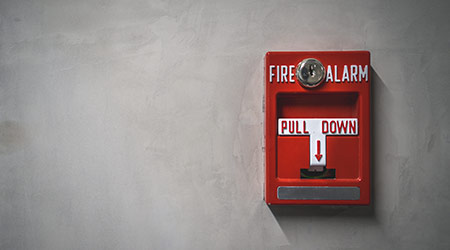Q: Does A/C power on a fire pump have to be monitored by the fire alarm panel? If yes, then where can I find the requirement in the NFPA standards stating this? Please help
A: Yes… A/C power is required to be monitored, along with a few other parameters. According to NFPA 20-2010, section 10.4.7 says where the pump room is not constantly attended, audible or visible signals powered by a source not exceeding 125 V shall be provided at a point of constant attendance. This means the pump must be monitor
10.4.7.2.1 The signal shall actuate whenever the controller has operated into a motor-running condition. This signal circuit shall be energized by a separate reliable supervised power source or from the pump motor power, reduced to not more than 125 V.
10.4.7.2.2.1 The fire pump alarm shall actuate whenever any phase at the line terminals of the motor contactor is lost. (This is the same as saying the A/C power must be monitored).
10.4.7.2.2.2 All phases shall be monitored. Such monitoring shall detect loss of phase whether the motor is running or at rest.
10.4.7.2.2.3 When power is supplied from multiple power sources, monitoring of each power source for phase loss shall be permitted at any point electrically upstream of the line terminals of the contactor, provided all sources are monitored.
10.4.7.2.3 This fire pump alarm circuit shall be energized by a separate reliable supervised power source or from the pump motor power, reduced to not more than 125 V. The fire pump alarm shall actuate whenever the three-phase power at the line terminals of the motor contactor is reversed.
10.4.7.2.4 Where two sources of power are supplied to meet the requirements of 9.3.2, this signal shall indicate whenever the alternate source is the source supplying power to the controller. This signal circuit shall be energized by a separate, reliable, supervised power source, reduced to not more than 125 V.
So, the following points are required to be monitored:
- Pump running
- Loss of power
- Phase reversal
- Pump connected to alternate power source
The above requirements are for new installations only. If your fire pump is not a new installation then it would have to comply with the code or standard in effect at the time it was installed or upgraded. But the 1999 edition of NFPA 20 was referenced by the 2000 edition of the Life Safety Code, and section 7-4.7 of the 1999 edition of NFPA 20 says the same as above.
A NFPA code or standard on fire pumps has been around for over a hundred years, but monitoring all four points identified above has not always been a requirement. If your fire pump installation is rather old, then you would have to determine which edition of NFPA 20 was in effect at the time the pump was installed and examine that to determine which points you are required to monitor. I do know from experience that a fire pump installed in 1965 is required to have the loss-of-power monitored. Older editions of NFPA 20 are available from the NFPA archives.
But if you renovate, update, or replace your old fire pump, then you must meet all of the NFPA 20-2010 requirements for new installation of fire pumps, which includes monitoring all four points, and placing the pump in its own separate room.
Brad Keyes, CHSP, is the owner of KEYES Life Safety Compliance, and his expertise is in the management of the Life Safety Program, including the Environment of Care and Emergency Management programs.

 Building Sustainable Healthcare for an Aging Population
Building Sustainable Healthcare for an Aging Population Froedtert ThedaCare Announces Opening of ThedaCare Medical Center-Oshkosh
Froedtert ThedaCare Announces Opening of ThedaCare Medical Center-Oshkosh Touchmark Acquires The Hacienda at Georgetown Senior Living Facility
Touchmark Acquires The Hacienda at Georgetown Senior Living Facility Contaminants Under Foot: A Closer Look at Patient Room Floors
Contaminants Under Foot: A Closer Look at Patient Room Floors Power Outages Largely Driven by Extreme Weather Events
Power Outages Largely Driven by Extreme Weather Events